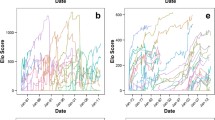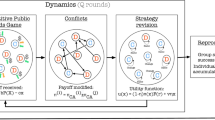Abstract
Since male primates are bigger and stronger than females, they are by default considered dominant. When in a cohesively grouping ape (but not in its loosely grouping relative), females often appear dominant to males, the static image of female weakness is maintained and female dominance is attributed to high, species-specific co-operation among several females against single males.
In this paper, an individual-oriented model is used to produce a parsimonious alternative: female dominance over males may directly vary with group-cohesiveness without species-specific differences in co-operative tendencies among females. The model consists of a homogeneous world in which entities roam. Entities are so constructed as to have merely a tendency to group and perform dominance interactions. ‘Male’ entities (StrongTypes) are characterised by a higher initial dominance value and intensity of attack than ‘female’ entities (called WeakTypes). Dominance values change and evolve due to the self-reinforcing effects of winning and losing contests. In the model, more rank-overlap between both types arises from a stronger feedback between dominance and spatial structure in cohesive than in looser groupings. Biological implications of these phenomena and testable hypotheses for real animals are discussed.
Access this chapter
Tax calculation will be finalised at checkout
Purchases are for personal use only
Preview
Unable to display preview. Download preview PDF.
Similar content being viewed by others
References
C. Drews, Behaviour 125 283–313 (1993).
P.M. Kappeler, Female dominance in primates and other mammals, Vol. 10, P.P.G. Bateson and e. al. (Eds), 143–158, Plenum Press, New York (1993).
B.B. Smuts, Gender, aggression and influence, B.B. Smuts, D.L. Cheney, R.M. Seyfarth, R.W. Wrangham and T.T. Struhsaker (Eds), 400–412, Chicago University Press, Chicago (1987).
B. Thierry, Journal of theoretical Biology 145 511–521 (1990).
T. Parish, Human Nature 7 61–96 (1996).
J.L. Deneubourg, S. Goss, N. Franks and J.M. Pasteels, Journal of Insect Behaviour 2 719–725(1989).
C.B. Stanford, Current Anthropology 39 399–420 (1998).
F.B.M. de Waal, Chimpanzee Politics: sex and power among apes, Harper and Row, New York (1982).
L. Ellis (Ed.), Reproductive and interpersonal aspects of dominance and status (1 Ed), Vol. 2, Greenwood publishing group, Westport (1994).
M. T. McGuire, G.L. Brammer and M.J. Raleigh, Hormones and behavior 20 106–117 (1986).
T.E. Rowell, Behav. Biol. 11 131–154 (1974).
I.D. Chase, C. Bartelomeo and L.A. Dugatkin, Anim. Behav. 48 393–400 (1994).
P. Hogeweg, MIRROR beyond MIRROR, Puddles of LIFE, C. Langton (Ed), 297–316, Adisson-Wesley Publishing Company, Redwood City, California (1988).
C.K. Hemelrijk, Proceedings of the Royal Society London B: Biological Sciences. 266 361–369 (1999).
B. Thierry, C. R. Acad. Sci. Paris 310 35–40 (1990).
C.K. Hemelrijk, Dominance interactions, spatial dynamics and emergent reciprocity in a virtual world, Vol. 4, P. Maes, M. J. Mataric, J-A Meyer, J Pollack and S.W. Wilson (Eds), 545–552, The MIT Press, Cambridge, MA (1996).
C.K. Hemelrijk, Cooperation without genes, games or cognition., P. Husbands and I. Harvey (Eds), MIT-Press, Cambridge MA (1997).
C.K. Hemelrijk, Adaptive Behavior (in press).
I.S. Bernstein and C.L. Ehardt, International journal of Primatology 6 209–226 (1985).
O.P. Judson, Trends. Ecol. Evol. 9 9–14 (1994).
C.P. v. Schaik, Behaviour 87 120–144 (1983).
P. Hogeweg and B. Hesper, Behavioral Ecology and Sociobiology 12 271–283 (1983).
C.K. Hemelrijk, Risk sensitive and ambiguity reducing dominance interactions in a virtual laboratory, Vol. 5, R. Pfeifer, B. Blumberg, J-A Meyer and S.W. Wilson (Eds), 255–262, MIT-Press, Cambridge MA (1998).
R.R. Sokal and F.J. Rohlf, Biometry: the principles and practice of statistics in biological research. (2 Ed), W.H. Freeman and company, San Francisco (1981).
S. Siegel and N.J. Castellan, Nonparametric statistics for the behavioral sciences (second Ed), McGraww-Hill internatioonal editions, New York (1988).
C.K. Hemelrijk, Animal Behaviour 39 1013–1029 (1990).
K.V. Mardia, Statistics of directional data, Academic Press, London and New York (1972).
P. Hogeweg and B. Hesper, J. theor. Biol. 113 311–330 (1985).
W.D. Hamilton, Journal of theoretical Biology 31 295–311 (1971).
J. Krause, Animal Behaviour 45 1019–1024 (1993).
J. Krause, Biol. Rev. 69 187–206 (1994).
C.P. van Schaik and J.A.R.A.M.v. van Hooff, Behaviour 85 91–117 (1983).
C. Boesch. Social grouping in Tai chimpanzees, W.C. McGrew, L.F. Marchant and T. Nishida (Eds), 101–113, Cambridge University Press, Cambridge (1996).
Author information
Authors and Affiliations
Editor information
Editors and Affiliations
Rights and permissions
Copyright information
© 1999 Springer-Verlag Berlin Heidelberg
About this paper
Cite this paper
Hemelrijk, C.K. (1999). Effects of Cohesiveness on Inter-sexual Dominance Relationships and Spatial Structure among Group-Living Virtual Entities. In: Floreano, D., Nicoud, JD., Mondada, F. (eds) Advances in Artificial Life. ECAL 1999. Lecture Notes in Computer Science(), vol 1674. Springer, Berlin, Heidelberg. https://doi.org/10.1007/3-540-48304-7_71
Download citation
DOI: https://doi.org/10.1007/3-540-48304-7_71
Publisher Name: Springer, Berlin, Heidelberg
Print ISBN: 978-3-540-66452-9
Online ISBN: 978-3-540-48304-5
eBook Packages: Springer Book Archive




